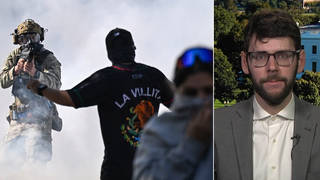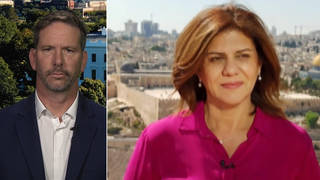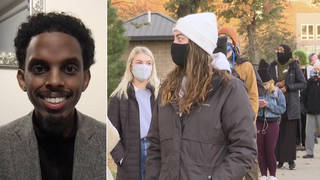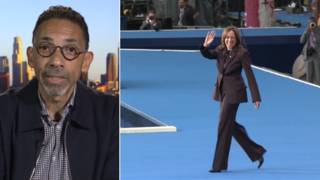
Guests
- John Nicholsnational affairs correspondent for The Nation.
Vice President Kamala Harris has selected Minnesota Governor Tim Walz, a favorite of many progressives in the Democratic Party, to be her running mate in the 2024 presidential race. They are set to hold their first joint campaign rally this evening. We get analysis from John Nichols, The Nation’s national affairs correspondent.
Transcript
AMY GOODMAN: This is Democracy Now!, democracynow.org. We have this late, breaking news. CNN is reporting that Kamala Harris has selected Minnesota Governor Tim Walz to be her running mate.
We go right now to John Nichols, The Nation magazine’s national affairs correspondent, to respond to this breaking news and who Minnesota Governor Tim Walz is, the significance. It looked like it was down to him and the governor of Pennsylvania, Shapiro.
JOHN NICHOLS: Tim Walz is a longtime schoolteacher and a guy who was born in Nebraska, moved up to Minnesota, worked for many, many years as a teacher and a coach, served in the National Guard, and then, in 2006, decided to run for Congress. He got elected in a, actually, quite rural and Republican-leaning district. And he’s been in politics since then.
The thing to know about Walz, first and foremost, is he is the current governor of Minnesota and often seen as one of the two or three, perhaps the most progressive governor in the country. And so, with Kamala Harris choosing Tim Walz, she has recognized the need to have a progressive from the Midwest on her ticket. It’s a significant development and one that I think will be cheered on — and, in fact, is being cheered on in this immediate moment — by a lot of folks in labor, a lot of folks in economic and social and racial justice movements, because Walz has been quite a good friend to them.
AMY GOODMAN: So, talk about the candidates and what you think actually took place. There was Mark Kelly, the Arizona senator, the husband of Gabby Giffords, who was shot in the head in an assassination attempt in Tucson. He is an astronaut. He’s a Navy pilot. And also talk about Shapiro, the Pennsylvania governor, because part of the choice here — right, John? — part of the significance of this development is, as you have talked about, the campaigns that were run and what Kamala Harris was looking for, which says a lot about, if she were president, how she would govern.
JOHN NICHOLS: It sure does. I think that’s a really good place to focus on this. Kamala Harris has been on kind of a whirlwind over the last six weeks, since Joe Biden’s very difficult debate performance on June 27th. And it’s only been a couple of weeks since she’s been the presumptive Democratic nominee for president. In a moment like that, you can go one of two ways. You can say, “Boy, everything’s so chaotic. I’ve got to lock in on something immediately and, you know, pick a candidate to run with me, and just tell everybody to get used to it.” Or you can — I think the much more confident route — say, “Look, we’ve got a little bit of time. Let’s open this up enough to hear the people who would like to have this role, and let them, effectively, conduct a virtual campaign.” That’s what she did.
And at the start of it, if you’ll go back, there were six or seven people on the list, mostly governors, maybe even some other folks who weren’t governors, obviously, Kelly from Arizona. And then, slowly but surely, the candidates kind of came forward. They understood the, if you will, dance that they were involved in. And so, they went on cable TV. They made appearances around the country. Some of them really campaigned aggressively, like Andy Beshear out of Kentucky, who went around the country and made appearances. Others were much more subtle, like Senator Kelly. But at the end of the day, everybody communicated what they wanted. They wanted to be in this position as the running mate.
And the interesting thing about Tim Walz was that he chose a route of doing a lot of cable and, frankly, going into the campaign mode — right? — almost acting as if he was the running mate already, going after Trump, going after Vance, in very effective ways in appearances. And I think that’s what we come down to here. The other candidates did it. Shapiro did it, unquestionably; Kelly, to some extent; and others. But Walz seemed to come through most effectively. And the thing that he did very early on was identify the Republicans — Trump and Vance and those folks — as “weird.” And the word took off. It actually got a resonance of its own. It wasn’t Walz necessarily who was the first to use it, but he became very identified with that, that sort of Midwestern kind of reaction to the Republicans, being aghast at them.
Now, I think that goes to the heart of your question, too, because you asked about the other candidates. Shapiro is a very effective speaker and somebody who’s very closely associated with Barack Obama. He also is from Pennsylvania. He is from an eastern state. Obviously, Kelly is from a western state. Harris herself is from California. And so, there’s this question, I think, that developed early on: Was Harris going to look at somebody who was from the middle of the country — right? — from where a lot of the battleground states are? Now, Pennsylvania is clearly a battleground state, but so, too, are Michigan, Wisconsin, to some extent, Minnesota, and a host of other states. And I think Walz communicated that he could be that candidate, that he could be very effective in that regard.
And then, the last stage of this campaign, if we look at it as such, was the point at which people started to step up and raise questions about individual candidates. There were questions about Kelly, the senator from Arizona, particularly regards labor, because he had not supported the PRO Act, which is an effort to make it easier to organize, and his failure to support that was noticed by a lot of people in labor and, frankly, progressive groupings. With Shapiro, there were a lot of things that came up, one of which was his very aggressive stance as regards student protests against U.S. policy on Gaza, and a lot of people that thought that he went to a more aggressive position of criticism than some other folks. But another thing that came up that was really strong was —
AMY GOODMAN: Comparing the Palestinian — pro-Palestinian protesters or the peace protesters to the KKK at one point.
JOHN NICHOLS: Yes. And that — I think that was not only off message, but also something that was noticed. People spoke about that and with great concern. But that wasn’t the only thing. There was also concern about the fact that Shapiro has been a supporter of or sympathetic to vouchers in education, and that’s a big-deal issue across a lot of these battleground states. And then there were a host of other concerns that came up.
And so, what ultimately happened, Amy, was that you had the candidates making their positive message — right? — their positive point for why they should be in, and then also some effort to point out what might be the liabilities, what might be the challenges, if you nominated one of these candidates. And at the end of the day, I think what happened was that Walz was very, very effective in his positive message, and very few people came forward and said, “Oh yeah, but he’s a bad guy in this, so there’s this thing we don’t like about him.”
And I think one of the really fascinating things was the extent to which people who had not been Walz backers early on came to him. And it was fascinating. I had people who had been very ardent backers of Kelly, that thought having a former astronaut on the ticket was a great thing; people who had been very ardent backers of Andy Beshear because Beshear had a very strong labor record; people who had been backers of Shapiro because he came from a very important swing state, Pennsylvania. And over time, especially in the last few days, you started to hear them saying, “You know, I really like this Tim Walz guy. I saw a video of him. I saw an old thing he did where he signed universal free lunch and breakfast for kids, all these different things.”
And I think, to be very frank about it, at the end of the day, Kamala Harris saw that, as well, and over this period of time, she came to a conclusion that this was somebody she could run with, and also somebody who could contribute significantly to this campaign, because Walz has a very understated Midwestern style, and yet, at the end of the day, he has delivered some of the most devastating critiques of the Republicans and of Trump and of Vance.
And so, I think we saw a remarkable process take place over the last few weeks, and it has ended up with a ticket that was unexpected at the beginning, but very probably the strongest ticket that could have come out of this.
AMY GOODMAN: John, what isn’t talked about so much, if Minnesota Governor Tim Walz and Vice President Kamala Harris become president and vice president, then the lieutenant governor of Minnesota, Peggy Flanagan, becomes governor, Minnesota’s 50th lieutenant governor, member of the White Earth Band of Ojibwe, currently the country’s highest-ranking Native woman elected to executive office. If you can talk about the significance of this?
JOHN NICHOLS: Well, you know, this became a big issue in considering all of the different possible contenders, because many of them were governors, and many of them had lieutenant governors. And one of the interesting things about the United States is that at this point the Democratic lieutenant governors across the country are one of the most impressive groups politically. They’re multiracial, multiethnic, many women, coming from all sorts of diverse and exciting backgrounds, frankly, people who really are kind of opening up a different politics. And so, there was a lot of talk about, you know, if somebody gets picked, then their lieutenant governor comes up.
Peggy Flanagan, out of Minnesota, has been a longtime active person in Minnesota. She’s been in politics. She was chosen to be the lieutenant governor candidate when Walz came up, because she was somebody who had risen to the statewide level and had a lot of support and interest in her politically. She is someone who comes from a background, an Indigenous background in Minnesota, and that’s a big deal, because Minnesota has a large number of Native peoples, as do many of the other battleground states. And so, Flanagan coming up is an interesting and exciting part of this development.
And here’s what’s really significant about it. She has been a real partner to Walz. They have been — they’ve worked very closely together. And so, her coming into the governorship at a point where Minnesota has a Legislature that is generally supportive of what the Democrats are doing, a Democratic Legislature, she’s going to herself be a high-profile governor very, very quickly, if indeed Walz becomes the vice president. And for Flanagan, I think — I’ve watched her, I’ve covered her over the years — she’s ready for this.
And so, we see this fascinating situation where so many things have happened, right? Joe Biden has stood down. Kamala Harris has stood up. Kamala Harris has selected Tim Walz. If Harris and Walz win, then Flanagan will become the governor of Minnesota, becoming one of the — becoming the first Native person to be governor of a state, also a woman, another woman leading a state, with a progressive Legislature. And so, when you put this whole scenario together, you realize that American politics is changing rapidly, and it’s happening in real time. And it all comes back to this amazing 2024 election cycle, which seemed just a few weeks ago to be so narrowly defined, right? It was going to be Biden versus Trump, and an awful lot of people were very disappointed by it. Now suddenly it’s opening up all over the place. Not only do we have a different ticket coming forward for the Democrats, you also have developments out in the states that are very significant, and Flanagan’s movement to the governorship is indeed very significant.
AMY GOODMAN: We will do, certainly, much more on this. There will be a big rally today. Stay tuned for tomorrow’s coverage. By the way, Democracy Now! will be broadcasting from the Democratic convention in Chicago, August 19th to 23rd. We will be expanding to two hours daily broadcast, as we did covering the Republican National Convention. You can tune in then and tell your friends and stations they can air Democracy Now!, the special expanded “War, Peace and the Presidency.” That does it for our show. I’m Amy Goodman, with Juan González, for another edition of Democracy Now!, grassroots, global news hour.












Media Options